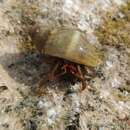mk
имиња во трошки


Clibanarius erythropus is a species of hermit crab that lives in rockpools and sublittoral waters.[2] It is found in the Mediterranean Sea, Black Sea and eastern Atlantic Ocean from the Azores to Brittany, the Channel Islands and as far north as the south Cornwall coast.[2][3][4] Individuals may grow up to a carapace length of 15 millimetres (0.6 in).[2]

A variety of different gastropod shells are used by C. erythropus, the most frequent being Littorina striata, Mitra, Nassarius incrassatus and Stramonita haemastoma, which collectively account for 85% of all the individuals studied in the Azores;[5] in the Mediterranean, shells of Cerithium, Alvania montagui and Pisania maculosa are most used by C. erythropus.[6]
Like other hermit crabs, C. erythropus feeds on "organic debris, decayed and fresh macro-algae with associated fauna and epiphytic algal flora, small invertebrates, and macroscopic pieces of dead and live animal tissues".[3] It has been shown that C. erythropus individuals select substrates where they can cover large distances, and that globose shells allow them greater mobility than elongate ones.[3]
In 2016 the BBC Springwatch programme highlighted C. erythropus and ran a competition to provide a vernacular name. The winning name was St Piran's crab, a process supported by National Trust West Cornwall and the Cornwall Wildlife Trust. Saint Piran is generally regarded as the patron saint of Cornwall, and was a hermit who survived being thrown into the sea.[7][4]
Clibanarius erythropus is a species of hermit crab that lives in rockpools and sublittoral waters. It is found in the Mediterranean Sea, Black Sea and eastern Atlantic Ocean from the Azores to Brittany, the Channel Islands and as far north as the south Cornwall coast. Individuals may grow up to a carapace length of 15 millimetres (0.6 in).
 Clibanarius erythropus, the Black Sea
Clibanarius erythropus, the Black Sea
Clibanarius erythropus (Latreille, 1818), è un crostaceo decapode della famiglia Diogenidae.
Comune lungo le coste rocciose, si trova spesso in conchiglie di Cerithium e Monodonta. È presente nel mar Mediterraneo e nell'oceano atlantico orientale[1].
Clibanarius erythropus (Latreille, 1818), è un crostaceo decapode della famiglia Diogenidae.
Comune lungo le coste rocciose, si trova spesso in conchiglie di Cerithium e Monodonta. È presente nel mar Mediterraneo e nell'oceano atlantico orientale.
Clibanarius erythropus is een heremietkreeft die voorkomt in de Middellandse Zee, Zwarte Zee en Atlantische Oceaan. De soort kan een carapaxlengte bereiken tot 15 mm.
Clibanarius erythropus is een heremietkreeft die voorkomt in de Middellandse Zee, Zwarte Zee en Atlantische Oceaan. De soort kan een carapaxlengte bereiken tot 15 mm.
Для схованки використовує черепашки гастропод різних видів, серед яких найчастіше Littorina striata, Mitra, Nassarius incrassatus і Stramonita haemastoma, які разом складають близько 85% всіх вивчених особин раків біля Азор;[5] у Середземному морі використовуються переважно черепашки Cerithium, Alvania montagui і Pisania maculosa.[6]
Як і інші раки-самітники, C. erythropus живиться органічними залишками, гнилими і свіжими макроводоростями та пов'язаною із ними фауною і флорою епіфітних водоростей, дрібними безхребетними і макроскопічними частини мертвих і живих тканин тварин.[4] Відомо, що С. erythropus віддають перевагу субстратам, де вони можуть вільно використовувати більшу площу, а серед черепашок молюсків віддають перевагу кулястим, ніж видовженим.[4]
Для схованки використовує черепашки гастропод різних видів, серед яких найчастіше Littorina striata, Mitra, Nassarius incrassatus і Stramonita haemastoma, які разом складають близько 85% всіх вивчених особин раків біля Азор; у Середземному морі використовуються переважно черепашки Cerithium, Alvania montagui і Pisania maculosa.
Як і інші раки-самітники, C. erythropus живиться органічними залишками, гнилими і свіжими макроводоростями та пов'язаною із ними фауною і флорою епіфітних водоростей, дрібними безхребетними і макроскопічними частини мертвих і живих тканин тварин. Відомо, що С. erythropus віддають перевагу субстратам, де вони можуть вільно використовувати більшу площу, а серед черепашок молюсків віддають перевагу кулястим, ніж видовженим.